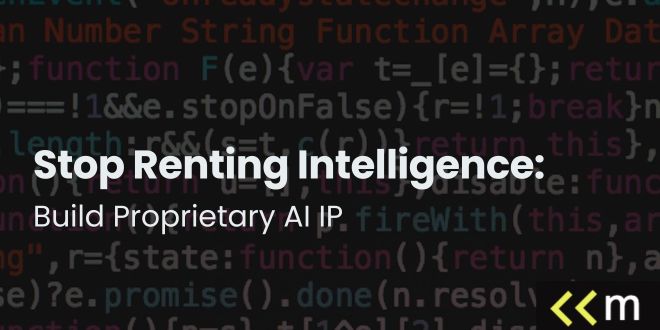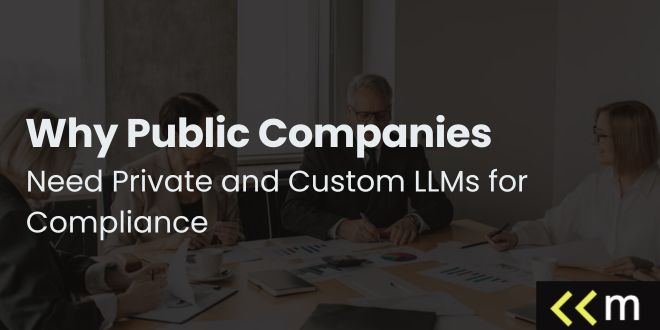Stop Renting Intelligence: Build Proprietary AI IP

Renting access to a cutting edge public LLM can feel like ordering intellect by the ladle, then discovering the soup belongs to the chef next door.
You can taste it, you can serve it, but you never own the recipe.
The first week is intoxicating because prototypes pop like fireworks and stakeholders applaud.
Then reality taps the microphone.
Costs swell with traffic, roadmaps bend around vendor limits, and a proud brand becomes a sticker on someone else’s engine.
If you want an advantage that compounds, stop renting intelligence and start building proprietary AI IP, with a custom LLM.
Why Renting Intelligence Holds You Back
When your core product depends on rented cognition, you inherit volatility. Terms of service change after your launch announcement.
Rate limits tighten on the day you run a promotion. When external models improve, the direction is set by someone else’s priorities, not by the peculiar shape of your customers’ problems.
Strategy turns reactive instead of deliberate. That instability bleeds into hiring plans, capacity forecasts, and even your customer contracts, since you cannot promise what you cannot predict. There is a quiet erosion of identity. If rivals can call the same endpoint, differentiation collapses into surface polish.
You ship similar answers in a slightly different voice, and the market shrugs. If the decisive steps in the user journey happen inside a black box you do not control, the box collects the value and you collect the invoices.
The IaaS Versus Ideas as a Service Trap
Cloud infrastructure lets builders rent electricity without surrendering the blueprint. Ideas as a service flips that bargain. You borrow reasoning itself. This works until the work becomes mission critical. Hiccups land in your inbox as tickets you cannot diagnose. Dashboards explain symptoms but not causes, and the team becomes expert at refreshing status pages instead of fixing underlying behavior.
The Hidden Tax on Speed and Differentiation
Speed is a loop. You observe, you change, you measure, you repeat. If the levers for change sit outside your walls, the loop stretches and momentum fades. Latency grows from network hops and queueing. Improvements wait on third party schedules. Renting replaces both feedback and fixes with a polite request form.
What Counts as Proprietary AI IP
Ownership is not a single artifact. It is a connected set of assets that learn together. Picture a living dossier on how your product should think, speak, and decide. The dossier includes data that reflects your domain, model components that encode your judgment, evaluation suites that define quality, and a runtime that observes outcomes and feeds them back into the system.
You can mix open models and commercial licenses inside this dossier, yet the shape of the whole becomes uniquely yours. Treat the dossier as a product that ships on a cadence, with changelogs, owners, and measurable impact, not as an academic scrapbook.
Data Moats That Actually Matter
Not all data earns the title of moat. Click soup and log confetti add weight without wisdom. The AI moat forms when you capture decision grade signals. Store prompts with outcomes and human judgments that explain why results succeeded or failed. Track lineage so every example is traceable to its source and consent. Clean and defensible data is hard to copy because it encodes how your users define value.
Model Artifacts You Own End to End
Weights matter, yet so do the recipes. Tokenizers, adapters, reward models, and training curricula form a signature that reflects your taste. You may blend third party components, but the way you combine and tune them becomes distinct. Document it, version it like code, and treat it like a crown jewel.
The Stack You Should Control
Control the parts that decide identity, quality, and cost. You do not need to reinvent physics or write custom kernels to win. You do need a build loop that learns from your usage faster than competitors can imitate. That loop begins with clean data, continues with targeted adaptation, and ends with observability that shows what to fix next.
Data Layer: Clean, Structured, Compliant
Make your corpus boring in the best way. Deduplicate near twins, strip secrets, and normalize formats. Build golden questions that mirror real user intents with unambiguous answers. Design rubrics that score helpfulness, accuracy, safety, and tone. Build lightweight tools that let product and support teams propose new golden questions in minutes, because curation speed matters as much as model speed. Keep schemas versioned so everyone debates changes with the same definitions.
Modeling Layer: From Baselines to Bespoke
Begin with reliable baselines, then teach them your domain. Use fine tuning or adapters to encode terminology, product knowledge, and boundaries. Evaluate blindly against your golden sets so improvements are earned, not imagined. Add preference models that reflect your brand’s voice. The goal is a predictable engine that improves whenever you feed it better evidence.
Inference Layer: Routing, Guardrails, Observability
Production is where ideas meet physics. Build a router that chooses among several models, including your own. Let routine requests use a lightweight path and complex ones escalate to heavier models. Enforce schema checks and safety filters before anything touches a customer. Capture traces with inputs, outputs, latencies, and routing decisions. Without traces, you are guessing and you cannot prove what happened.
A Practical Path to Ownership
You do not need a research campus to start. Ownership grows through stages that create value immediately. Wire learning into the product so every interaction can become training fuel when you choose to harvest it.
Phase 1: Instrumentation and Ground Truth
Ship metrics with features. Record success signals such as task completion and time to resolution. When a user edits a response, treat it as a low cost label. When they repeat a question, treat it as missing context. Build a labeling guide that anyone in support can follow. Reward concise notes on why an answer was good or bad.
Phase 2: Adaptation and Evaluation
With ground truth in hand, adapt. Run small fine tunes and compare them to baselines. Maintain a leaderboard that tracks exact match accuracy, factual consistency, tone adherence, and safety. Re-run it when you change data, prompts, or code. Numbers focus attention.
Phase 3: Optimization and Governance
Once your bespoke system wins on your own tasks, tune cost and reliability. Add feature flags so you can roll forward and back without drama. Run chaos drills that simulate provider outages and malformed inputs so you know exactly how the system fails and how quickly it recovers. Define clear policies for data retention, model retraining cadence, and incident response. It is the wiring that keeps the lights on when the weather turns ugly.
Risk, Compliance, and Patents
Invite your security and legal partners before the first fire drill. Map data flows so you can explain what touches what and why. Maintain audit trails for training and inference. Automate redaction at ingestion and create per purpose data access so experiments never pull more than they need.
If patents matter to your strategy, track the novel pieces and how they interact. It lets you partner without surrendering the crown, and it helps you defend your work when copycats arrive.
Culture, Talent, and the Long Game
Technology follows culture. If model work feels like a side quest, it will stay small. Treat it as a first class product surface. Pair researchers with product leaders and support agents who hear reality unfiltered. Invest in tools that make experiments cheap and safe.
Create a shared glossary for tone, facts, and forbidden phrases, then revisit it monthly with examples from real interactions so the model and the team converge on the same voice and boundaries. The long game rewards teams that learn faster, not teams that shout louder.
Conclusion
Stop renting the part of your product that makes the most important decisions. Own the loop that gathers evidence, adapts models, and measures outcomes. Start small, instrument everything, and let your evaluation sets speak louder than opinions. Store only the data you can defend.
Train only the pieces that change your results. Ship only what you can observe and fix. Partners will still matter, but the melody should be yours. When your fingerprints exist in the data, the model, and the runtime, you are not just using AI. You are investing in and building a private LLM asset that compounds, month after month, in a voice only you can own.
Eric Lamanna is VP of Business Development at LLM.co, where he drives client acquisition, enterprise integrations, and partner growth. With a background as a Digital Product Manager, he blends expertise in AI, automation, and cybersecurity with a proven ability to scale digital products and align technical innovation with business strategy. Eric excels at identifying market opportunities, crafting go-to-market strategies, and bridging cross-functional teams to position LLM.co as a leader in AI-powered enterprise solutions.







